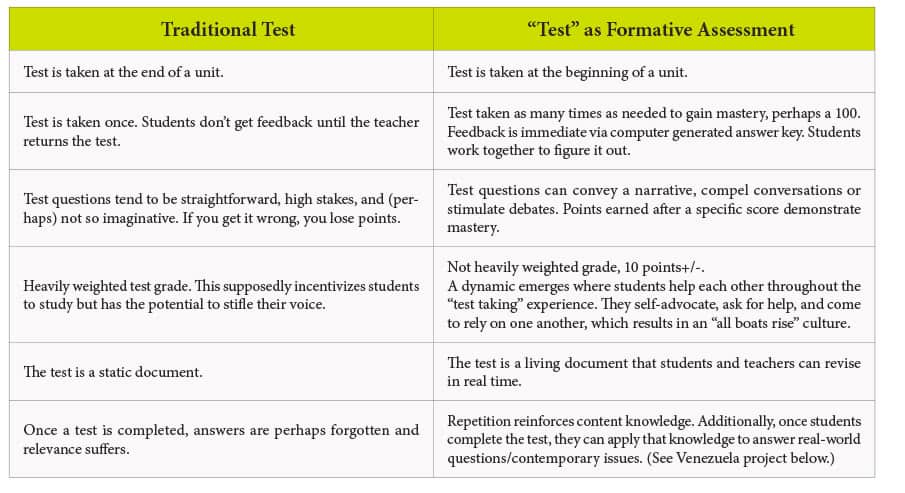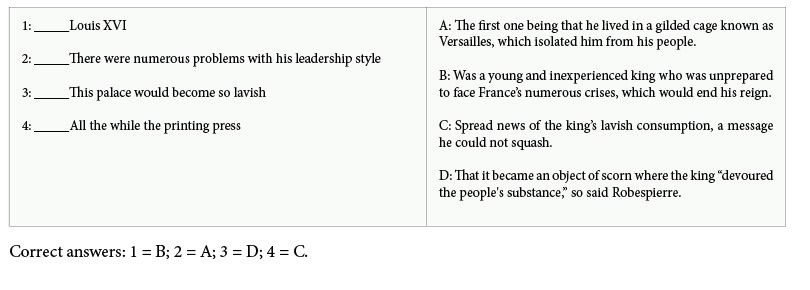By Glen Coleman
Testing needs to be reinvented. Instead of one-and-done paper-pencil testing, repurposed computer-based testing software can help transform the classroom into a student-centered, collaborative experience.
The chart below distinguishes traditional and innovative approaches to computer-based testing. When teachers leverage online testing’s superpower—instant feedback—students can better strategize ways to succeed and teachers can better craft lessons that create relevance between content and students’ interests.
 Let’s define “tests” in my class. They are, basically, 10-point assignments that codify course content; they could be as rigorous as a final exam but can be retaken until mastery. My initial expectation is generally 100; yet expectations may vary by class and context. An 85 might motivate students to work with great determination for an entire class period.
Let’s define “tests” in my class. They are, basically, 10-point assignments that codify course content; they could be as rigorous as a final exam but can be retaken until mastery. My initial expectation is generally 100; yet expectations may vary by class and context. An 85 might motivate students to work with great determination for an entire class period.
My “tests” are also taken in the beginning of a unit. Students work on the tests in small groups and are encouraged to teach each other the answers. If a student gets an answer wrong, they take the “test” again. This repetition helps develop grit and deepens content mastery. If not completed in a class period, it can be retaken at lunch—only correcting the questions that were wrong. Yes, they can bring a friend. The next day, I may require students to retake the same test without notes—independently, only once. Again, this is not tied to a heavily-weighted grade. This teamwork helps fuel engagement.
Repurposing testing software can elevate the questions that are “tested.” Instead of simply asking—for example, “Who is Louis XVI?”—I can now tell a story by creatively reimaging how to ask questions. For example, when teaching the French Revolution, I might ask questions like the ones below.

The matching section above is just one example of a dozen such questions I might ask to help students comprehend and appreciate larger themes. Again, I can revise expectations as students give feedback. (We can create them together, which could be its own article.) I generally craft questions to convey different kinds of learning on Bloom’s Taxonomy. For example: matching questions are useful to drive storytelling, multiple-correct-answer formats help to spur analysis of primary sources, and true/false choices can motivate close reading.
Revising tests collaboratively
But more important than students learning about the French Revolution, I wanted them to understand issues of 1789 in a 2020 context. So, in my testing, I created charts that required students to compare the history to contemporary issues: income inequality, national budgets and deficits, taxation policy, maps of foreign wars, and political cartoons. Through the test, we debated answers, attempted to create working conclusions, or revised questions for which we as a class could find no agreement.
Revising tests is as easy as projecting the working document on a screen for all to see as we modify it together. This gives students a voice, autonomy, clarity of purpose and helps forge a growth mindset and culture of collaboration. Now, most importantly, we can use this information for more inspired learning such as projects, debates, for example, our project on Venezuela.
Venezuela project and reinvented tests
In the 2019-20 school year, my colleagues and I developed what I believe turned out to be an inspired end-of-unit assessment on the French Revolution. Worth a test grade of 50 points, students were tasked with delivering two-minute speeches with no notes on this prompt: “Based on your understanding of the French Revolution, what can be done so that Venezuela avoids its own violent revolution?”
We Skyped with a Venezuelan family—the parents are teachers—and asked what they thought can be done to avoid Venezuela’s collapse. This galvanized students and staff to send the family more than 250 pounds of food and medical supplies. The family responded with a cellphone video of their singing “Amazing Grace” and “Guantanamera” to us.
The topic became urgent, profound, and required action; the history gave context to our conversation. This was facilitated by the formative test that the students took at the start of the unit, which made the topic accessible, conversable and relevant. The test gave the students the context in which to discuss the calamity happening in Venezuela today.
After students Skyped, crafted and delivered speeches—students delivered them at least twice, once with peer review by all classmates, the other time one-on-one with me—I surveyed students and asked how they found the three-pronged approach, which consisted of:
- Taking the test collaboratively.
- Retaking it individually.
- Applying their knowledge to Venezuela’s turmoil.
Ninety-two percent of students said they thought the system worked and identified different reasons. Some liked the clarity of expectations of the test, that it explained material clearly or spurred collaboration; several appreciated that they could retry until mastery. What I liked was the fact that the test did not count as a test. The need to succeed was constructed through peer motivation.
Over the past few years, I have surveyed students on this system: first take the test together, next take it individually, finally use it to express something meaningful through an essay, speech, or project. Below are quotes from students. Overall, they like the system. The collaboration, clarity, and content give projects rich historical context arrived at by a highly student-centered engagement. Here is a sample of what students are saying:
- I think 100-or-Nothing Quia [online “tests” at Quia.com] is better because you really have to know the material to pass. To get 100 on them, you have to take it multiple times to get 100, which in my opinion, is better because you better understand the material each time you take the Quia.
- Doing the 100-or-Nothings are good practice. It is even better when we have the Quest the next day because the information is still fresh in our minds, so it is easier to take the Quest [take test once, no notes, independently]. I have never been a fan of essays, but I do think they are good to learn new/more information about the topic.
- I feel as though the system has been working for me although the essays can be a stretch at times. They are in fact fun to write, but sometimes they confuse me. I feel as if we spent one more day going over the 100-or-Nothing, I can retain the most important information. The essays are fun at times and bring new topics to the class which is interesting to hear.
- I like doing an essay or discussing a larger question because then I know where I’m at with my understanding. But I don’t want to do an essay for every single topic.
- I think that the system is good because you learn by doing the 100-or-Nothing. Then, you get tested on what you remember. Then you expand your knowledge about interesting, real world topics.
One-and-done end-of-unit testing limits learning. Let’s reinvent tests so that they serve as a formative yet crucial step towards student empowerment.
Dr. Glen Coleman teaches social studies at River Dell High School, is an HP Teaching Fellow for using technology for powerful learning, and hosts a podcast, Teacher Breathe. Coleman is nearing publication of his first book on how COVID is causing the reinvention of teaching. He can be reached at info@teacherbreathe.com.
Getting started
To get started, employ a good web-based, test-taking program with the qualities listed below. I like Quia.com.
- It is important to have the option to change when students can see the answer key. Ninety-nine percent of the time, I want students to see the entire test and answer-key at the beginning of a unit.
- As teachers, you want the flexibility to randomize question order.
- Make sure your testing application allows you to easily insert graphics, such as maps, art, charts, political cartoons or excerpts from books.
- Students need to be able to access all their tests so that they can identify what they got wrong.
- The more question types available the better. These are helpful: matching, fill-in blank for a paragraph (not just a sentence), multiple correct answers.
- Time stamps are helpful because they can provide a metric of work ethic as reported on a spreadsheet. It would report when a student studied, how many times they attempted a test, and for how long they worked.
- In the online environment, we have to be creative.
